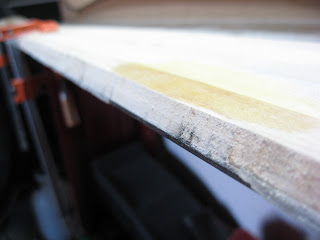Adding a plastic side wall gives the ski a clean look and will protect the core from damage. They add expense and time to the design as they have to be attached with epoxy to the core. The plastic used for the sidewall (P-tex) is more dense than wood and has a lower modulus of elasticity (much more flexible) and therefore adds weight to the ski without adding strength.
The cap design is simpler and doesn't require that a plastic sidewall be used. The core is beveled on the edges and the top sheet is wrapped down over the edge of the the core. This design reduces the weight of the ski because beveling the core removes material. Beveling the edges does not compromise the strength of the ski because when the ski is used to make a turn, force is applied at the edge of the ski and is reacted by the boot/binding. The bending stress across the cross section is smallest at the edge of the ski and increases linear towards the boot mounting point.
The complication that this design adds is that the core must be beveled to allow a cap to be used. Since I do not have the ability to precisely machine the core to the size of the base, I use a two-stage pressing process. In the first stage, the base, edges, fiberglass, rubber and core are molded together. Once pressed, the flashing is trimmed off and the core is beveled precisely using the edge of the ski as a guide. In the second stage the second fiberglass layer, graphics, and top sheet are pressed to the stage one press group.
One of the key steps in pressing the ski is to get the base and the core properly aligned. In order to do this, I constructed a jig for the mold using ski edging which would precisely align the base and edges.
In order to align the core I glue two pre-drilled blocks of wood to the side of the core at the centerline. Prior to final layup, I align the core to the base on the mold and drill alignment holes through the predrilled blocks of wood. Finish nails will be place through the hole in the block of wood on the core and into the holes in the mold for alignment. A more complex and repeatable method could be designed for this process, but I have low volume production and this method works well.
Once the alignment pieces are attached to the core and a test alignment has been completed, all of the components of the ski need to be staged for layup. First, a piece of thin plastic is placed on the mold; this is used to prevent extra epoxy from sticking to the mold and ruining it. The base and edges are then put in place. The core, fiberglass, and rubber strips are then staged near the mold. A foam brush is also staged for spreading the epoxy. The reverse mold, air bladder, and air compressor must also be staged.

Once the components are stage, the expoxy needs to be mixed. This year I used West System epoxy. The hardener I chose, 206, is used for a slow cure time. The usable time is anywhere from 30-45 minutes with this epoxy. After this time the epoxy starts to harden. At 9-12 hours the epoxy reaches full hardness and reaches full strength by 24 hours. I always recommend rubber gloves (chemical resistant) and safety glasses. A well ventilated area is also recommended.
Once the epoxy is mixed it is time to apply it to the ski and place the ski in the press. The following video is shown at 12X speed and demonstrates this process.
The following photo illustrates the shape of the ski after molding. Since the ski is pressed into shape, stress is locked into the wood and will cause the ski to spring back a small amount when it is removed from the mold. To compensate for this, the mold must exagerate the shape of the ski. For the Arlia's shown below, the camber on the mold was designed at 30mm expecting a final camber of 15mm. A measurement after removal from the mold showed a camber of 14mm.
The next step is to trim the flashing (http://en.wikipedia.org/wiki/Molding_flash) from the ski. This can be done with a band saw, router, or jig saw. Since my band saw is out of comission this season, I used my jig saw. In order to save a step I set the jig saw to a 30 degree angle and cut the bevel of the core at the same time.
Trimming the flashing is one of the more difficult processes because it is time consuming and the cutting tool wears out quickly. The jig saw blade cuts through epoxy, fiberglass, and the wood core; at the same time the edge of the ski is used as a guide. All these factors cause the blade to build up heat quickly. After every six inches of cut, the blade had to be cooled, otherwise it would overheat causing the metal to soften and the teeth to wear more quickly. A coarse tooth, quick cutting blade is reccomended over a fine tooth blade (clean cutting) as it will cut quicker and last longer.
Once the flashing is trimmed and the bevel is created, a belt sander is used to even out any flaws in the cut and create a rounded edge where the bevel meets the top of the ski.
Once this is complete the ski is ready for stage two pressing.






















wow- that was amazing to see the actual work involved. They are lucky you aren't charging them by the hour to make the skis-
ReplyDelete